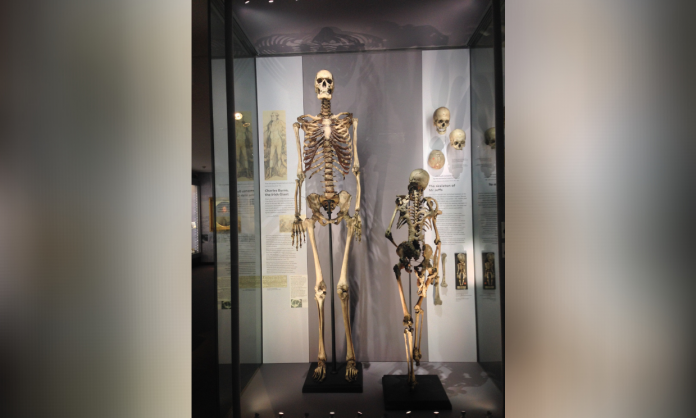By Martin Gleeson
Charles Byrne was born in 1761 in Littlebridge, Co. Derry, not far from the shores of Lough Neagh. His parents were of average height, but once Charles reached his early teens, he realised that he had extraordinary height and that this would provide him with an easy living.
Today researchers know that Charles Byrne’s height was due to a pituitary disorder called gigantism.
London
As soon as he reached his teens, Charles began his search for fame and fortune. He started in Scotland, where he was an immediate success, charging people for interviews with the tall Irishman. In Edinburgh, the night watchman was amazed to see Charles lighting his pipe from the street lamps without standing on tiptoe!
Reports at the time say that Charles was 8 feet 2 inches, or 8 feet 4 inches, but his skeletal remains tell us that he was just over 7 feet 7 inches.
Charles’ fame spread as he made his way down through England. He arrived in London, then the centre of the Empire, in early 1792, aged 21. He entertained paying guests in rooms in what is now Piccadilly and later Charing Cross. A London newspaper described him as “a modern living Colossus, or wonderful Irish Giant.” Everyone wanted to meet and marvel at the towering wonder of nature.
His gentle nature and popularity with the public was constantly covered in the newspapers. He was the talk of the town in London, and he inspired a hit London stage show called ‘The Giant’s Causeway’.
Ill Fortune
At the height of his fame, Charles’ health began to decline, due to his growth disorder. Also, disaster struck when all his earnings, which he kept on his person, were stolen from him while he was drinking in his local pub. This loss, combined with his failing health, caused Charles Byrne to die in his lodging house in June 1783, aged only 22.
Charles Byrne’s Skeleton
While Charles’ health was deteriorating, he was adamant that his skeleton would not be used as a display item. He made arrangements with friends so that when he died, his body would be taken to the coastal town of Margate and then to a ship for burial at sea.
However, at that time, the eminent surgeon and anatomist, John Hunter, was living in London. He arranged for Charles’ body to be stolen on its way to Margate.
Hunter reduced Charles’ corpse to a skeleton and later put it on display in his own museum.
The 7 foot 7 inches skeleton was bought in 1799 by the museum of the Royal College of Surgeons in London, and continues to be on display there, though the museum is at present closed for refurbishment and will reopen this year.
Today, over two hundred years after his death, the skeleton of Charles Byrne creates controversy. Many feel that it should no longer be used as a curiosity item to be stared at by the general public.
Some think that Charles’ wishes should be respected and that his bones should be buried at sea. Others think that he should be given a decent burial in the country of his birth, Ireland.








